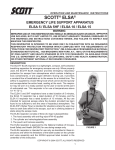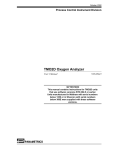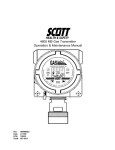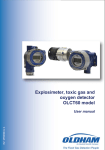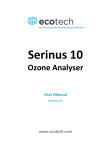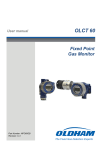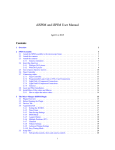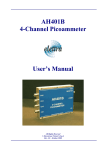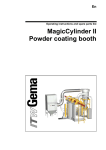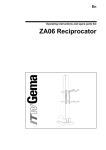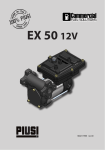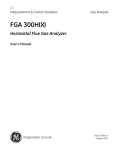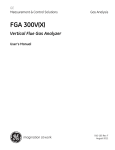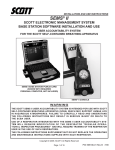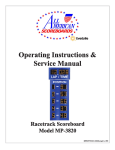Download Freedom™ 5000 - Scott Safety
Transcript
Freedom™ 5000 Universal Analog Toxic Gas Transmitter Operation & Maintenance Manual Rev: C Date: 09/12/07 ECN 128164 Part Number 087-0020 i ii CONTENTS Introduction Unpacking 1 Freedom™ 5000 ________________________________________ 1 General Description ______________________________________________1 The Scott Health & Safety Gas Sensor Overview of Sensor Operation _____________________________________3 The Sensor and Battery ______________________________________ 3 Gas Specificity _____________________________________________ 4 Sensor Accuracy____________________________________________ 4 Sensor Response Times _____________________________________ 4 Sensor Life ________________________________________________ 4 Environmental Influences to the Scott Health & Safety Sensor ________ 5 Sensor Oxygen Requirements _________________________________ 6 Sensor Intrinsic Safety _______________________________________ 6 Sensor Handling and Disposal _________________________________ 6 Series 5000 Transmitter General ___________________________________________________ 7 Specific ___________________________________________________ 7 Freedom™ 5000 Installation Location Considerations ______________________________________ 10 Typical Power Consumption ___________________________________ 11 Physical Installation and Wiring ________________________________ 11 Remote Sensor Junction Box Mounting __________________________ 16 Twist Lock Accessories ______________________________________ 17 Start – Up Initial System Start – Up ______________________________________ 18 Alarm and Loop Power Inhibit _________________________________ 18 Setting Inhibit Loop Current ___________________________________ 18 Calibration Frequency________________________________________ 19 Remote Sensor Calibration____________________________________ 20 Storing Sensors ____________________________________________ 20 Zero Calibration ____________________________________________ 21 Zero Calibration Using Ambient Air______________________________ 21 Using A Permeation Tube Device_______________________________ 21 Zero Calibration Procedure____________________________________ 21 Span Calibration ____________________________________________ 22 iii CONTENTS (CONT.) Start – Up, cont. Span Calibration Procedure ___________________________________ 22 Important Notes on Calibration of Sensors ________________________ 23 Weekly Operational Response Checks __________________________ 24 Fail Indications _____________________________________________ 24 Over Range Indications ______________________________________ 24 Sensor Strength Failure Indication ______________________________ 25 Sensor Self-Test (SST) Failure Indication ________________________ 25 Fault Codes _______________________________________________ 25 Sensor Self Test Option ________________________________ 25 System Maintenance General ___________________________________________________ 28 Sensor Maintenance_________________________________________ 28 Sensor Replacement ________________________________________ 28 Elastomeric Connector _______________________________________ 28 Making Operational Check Gases ______________________________ 29 Troubleshooting General ___________________________________________________ 30 Isolating Sensor Failure ______________________________________ 30 Using the Sensor Simulator ___________________________________ 30 Zero Drift and False Alarms ___________________________________ 31 Poor Electrical Connection ____________________________________ 31 Fault Codes and Error Messages _______________________________ 31 Circuit Boards ______________________________________________ 32 Removing Circuit Board ______________________________________ 32 Product Returns & Service Contact Information ____________________ 33 Spare Parts Gas Plus Sensors ___________________________________________ 34 Rock Solid Sensors _________________________________________ 36 Miscellaneous ______________________________________________ 38 Accessories _______________________________________________ 38 ¼ Turn Calibration Accessories ________________________________ 38 Replacement Circuit Boards and housing parts ____________________ 39 Freedom™ 5000 Model Configuration ___________________________ 40 iv CONTENTS (CONT.) General Warranty __________________________________________________ 41 Year 2000 Compliance _______________________________________ 41 Contacting Scott Health & Safety _______________________________ 42 Specifications Technical Specification _______________________________________ 42 Sensor Specifications ________________________________________ 43 Loop Loading (4-20ma) ______________________________________ 45 Appendix Intrinsic Safety _____________________________________________ 46 Intrinsic Safety Wiring Diagram ________________________________ 48 Non-hazardous Area Wiring Connections_________________________ 49 Gas Selectivity Chart Manual Insert Manual Figures Figure 1 – Freedom™ 5000 w/ Integral Sensor ____________________ 2 Figure 2 – Sensor Overview ___________________________________ 3 Figure 3 – Freedom™ 5000 Interface____________________________ 7 Figure 4 – Freedom™ 5000 Inside View w/ P.C.B.A.’s ______________ 9 Figure 5 – Freedom™ 5000 Dimensional Drawing__________________ 10 Figure 6 – Mounting L-Bracket Option ___________________________ 12 Figure 7 – Wiring & Testing Diagram ____________________________ 13 Figure 7A – Wiring Terminals & Test Points _______________________ 14 Figure 8 – Sensor Installation __________________________________ 14 Figure 9 – Elastomeric Connector Installation _____________________ 15 Figure 10 – Freedom™ 5000 w/ Remote Sensor ___________________ 16 Figure 11 – Calibration Adapter ________________________________ 17 Figure 12 – Duct Adapters ____________________________________ 17 Figure 12A – Flowcell ________________________________________ 17 Figure 13 – Inhibit Flag _______________________________________ 18 Figure 14 – Inhibit Mode ______________________________________ 19 Figure 15 – Zero Calibration ___________________________________ 21 Figure 16 – Freedom™ 5000 w/ SST Option ______________________ 26 Figure 17 – SST Generator ___________________________________ 27 Figure 18 – Sensor & Elastomeric Connector______________________ 28 Figure 19 – Sensor Simulator __________________________________ 30 Figure 20 – Loop Loading_____________________________________ 45 Figure 21 – Intrinsically Safe Wiring Diagram______________________ 46 Figure 22 – Connector Wire Legends ____________________________ 47 v Introduction Unpacking All Freedom™ 5000 items are individually packaged. Carefully, open each box and remove the items. Each package comes with a magnet, operations manual as well as the transmitter itself. If a sensor was purchased with the transmitter it will be in a separate container (typically blue plastic) shipped with the Freedom™ 5000. Accessories such as calibration adapter, rain shield, duct mount adapter, and flow cell will be inside the 5000 shipping container. DO NOT DISCARD THE ELASTOMERIC PAD LOCATED INSIDE THE SENSOR HOUSING AS THIS PIECE IS REQUIRED FOR OPERATION Identify all items with your Order and Packing list. Examine for external damage. If any is found, or if any item is missing, notify Scott Health & Safety Customer Service immediately at: Scott Health & Safety 4320 Goldmine Rd Monroe, North Carolina 28110 USA Telephone (704)291-8300 FAX (704) 291-8340 www.scotthealthsafety.com Freedom™ 5000 The Scott Health & Safety Freedom™ 5000 Instrument is designed to detect the presence of a specific toxic gas so that human life may be protected from the potential hazardous conditions created by toxic gas environments. Each Freedom™ 5000 complete instrument consists of: A GasPlus Sensor – Providing toxic gas, oxygen deficiency, or hydrogen detection. A Series 5000 Transmitter – Providing a Digital display of the specific Toxic Gas detected in PPM (Parts per Million), PPB (Parts per Billion), or % v/v (Percent by Volume) depending on the specific application and sensor used. A Magnet & Operations Manual – The magnet is used to interface with the magnetic reed switches located on the front panel of the 5000. General Description The Freedom™ 5000 toxic gas transmitter is a universal loop – powered microprocessor controlled 4–20 mA device, which allows any of the GasPlus toxic gas “smart” sensors (excluding the Model 88 combustible sensor) to be used for the detection of a specific target gas. When properly installed, non-intrusive operation of the transmitter and an intrinsically safe design, when used with an approved barrier, permit the Series 5000 to be operated and calibrated within potentially explosive environments without having to declassify such areas. 087-0020_C ECN 128164/MRJ 09/12/07 1 Freedom™ 5000 with Integral Sensor Figure 1 087-0020_C ECN 128164/MRJ 09/12/07 2 THE SCOTT HEALTH & SAFETY GAS SENSOR Overview of Sensor Operation Scott Health & Safety manufactures two types of electrochemical gas sensors. These being the traditional GasPlus sensor and the Rock Solid GasPlus sensor. Both sensor types provide reliable gas detection but the Rock Solid sensor provides superior zero stability, faster response time, and higher specificity to the target gas. Both of these specialized electrochemical gas sensors detect target gases for which they were designed through a series of electrochemical reactions. Gas passes through a gas permeable membrane where it then contacts an electrolyte – saturated membrane. The gas is then oxidized or reduced (depending on the gas) at the sensing electrode, and the reaction is balanced at the counter electrode. In most traditional sensors, a third electrode acts as a reference to maintain a fixed potential at the sensing electrode. As gas concentration increases, a corresponding increase in current output occurs. The current output is measured and amplified, then converted by the Series 5000 transmitter to a signal on the 4–20 mA loop where it is used to read gas concentration. Figure 2 087-0020_C ECN 128164/MRJ 09/12/07 The Sensor and Battery Each GasPlus ‘smart’ sensor contains circuitry with an EEPROM and lithium battery. The EEPROM retains specific sensor data including gas measuring type, range, alarm setpoints, and sensor calibration factor. When connected to the transmitter, the sensor data is up loaded to the transmitter. Upon disconnection of the GasPlus sensor from transmitter assembly, the bias potential (required by electrochemical sensors) across the sensor’s electrodes will be maintained via the integral battery. The battery is capable of providing up to a total of 9 months of “off - line” power (because the battery is not rechargeable, “off - line” time is cumulative), providing proper storage procedures are followed. Store the sensor in a cool dry place(such as a refrigerator). Do not store the sensor in excessively hot, dry or humid environments. Should the sensor be kept off-line for a cumulative period of time exceeding 9 months, the sensor will continue to operate! Sensor battery failure does not mean the sensor has failed and will not operate, only that it will require a 4-8 hour warm-up time upon installation. On the sensor has become stable, calibration may occur as normal. 3 Gas Specificity Sensor battery failure does not render the sensor useless but it will require a 4-8 hour warmup time upon installation. Each gas sensor is engineered and designed to be gas specific; however, the very nature of electrochemical gas detection is such that the presence of certain gases may act as an interferent to certain sensors. Each sensor can have its own interferent(s), causing the sensor to respond electrochemically. Scott Health & Safety has tested and documented some of the known interferents. These are listed in an Addendum located in the back of the manual. Sensor Accuracy The accuracy of a toxic gas sensing system is limited by the accuracy of the standard used to calibrate the system. For many toxic gases, obtaining a high accuracy standard that is suitable for field calibration use may be difficult (about the best accuracy of gas concentration achievable is 5%, using a permeation system with good temperature control). For this reason, no fixed accuracy statement is possible. The accuracy of the GasPlus sensor cannot be better than the accuracy of the calibration gas. The best accuracy to be expected, assuming a perfect standard, is limited by the repeatability which is 2% of span (full scale) and linearity which is 2% of span . Sensor Response Times Electrochemical Gas sensors are optimized to give the fastest possible response time while maintaining excellent zero stability and minimum drift (approximate sensor response times are available from Scott Health & Safety). If response time appears to be slow, refer to the “Weekly Operational Checks” within the System Operation section. Sensor Life Because applications are of such a variable nature, only experience on a given application can truly tell what the sensor life will be. GasPlus sensors will generally provide a minimum of 12 months of service in ambient air gas detection applications. Extremes of humidity and temperature, and exposure to dirty atmospheres containing particulate matter or oily vapors will decrease sensor life. In addition, extended exposure to target or other active gases may shorten sensor life. In applications where only trace levels of a target gas exist, except under leak conditions, sensor life will most likely be over 18 months. A phosgene sensor has an expected life of 30 weeks from manufacture. While sensors may have some, or even substantial life remaining, it is recommended that sensors be replaced at a convenient interval between 12 and 24 months. Experience in a given application or plant condition will determine the best replacement frequency. 087-0020_C ECN 128164/MRJ 09/12/07 4 Environmental Influences to the Scott Health & Safety Sensor Although the Freedom™ 5000 transmitter is designed to operate at temperatures from -40 to 140 F (-40 to 60 C), the operating temperature is dictated by which gas sensor has been installed. The GasPlus Sensor Operating Parameters Addenda (see back of manual) show the operating temperature ranges for each sensor type. Extreme hot temperatures and exposure to dirty atmospheres containing particulate matter or oily vapors can affect sensor response and decrease sensor life. Extreme cold temperatures, if below the rated value of the sensor, have the potential of freezing the sensor electrolyte and thus damaging the sensor permanently. Humidity (%RH) has the potential to affect the performance of electrochemical sensors. Gas sensors are designed to provide stable output over a range of humidity conditions. Intermittent exposure to relative humidity conditions from 10% to 99% non-condensing RH will not affect operation of most sensors. Scott Health & Safety typically provides a low humidity version (electrolyte balanced for 50% R.H. equilibrium) and a high humidity version (electrolyte balanced for 75% R.H. equilibrium) sensor. Most indoor HVAC controlled environments will use a low humidity sensor while most outdoor applications will use a high humidity version. In those applications where there is doubt as to which sensor should be used it is advisable to use the high humidity version. Contact your Scott Health & Safety representative for assistance in selecting the proper type for your application. Extremely dry air has the potential to adversely affect the operation of electrochemical sensors. At a R.H. continuously below 25%, sensors can exhibit an early loss of sensitivity after a few days to a week of operation. This is caused by a slow loss of water from the internal sensor electrolyte. Suspending the sensor over a jar of water for 24 hours will usually restore sensitivity. Extremely humid or wet conditions can affect these sensors which rely on an unobstructed gas diffusion path into the sensor. If the gas stream or ambient air allows humidity to condense on the sensor, the water on the membrane will cause loss of sensitivity, or slow response, or both. Once the sensor has had a chance to dry out, normal operation should be restored. If the source of moisture is a result of water spray or rain, a rain shield may be installed on the sensor module to protect the sensing membrane. Keep in mind that some gases may chemically react with water vapor and be converted to other species (e.g., ammonia hydrolyzes to form ammonium hydroxide when exposed to water vapor). In addition, other gases such as hydrogen fluoride are very reactive and may be absorbed on the inner surfaces of flow tubing before reaching the sensor during calibration. Such questions should be referred to chemists or industrial hygienists. 087-0020_C ECN 128164/MRJ 09/12/07 5 Sensor Oxygen Requirements Scott Health & Safety “traditional” (not Rock Solid) gas sensors require a minimum of 5% oxygen for continuous operation under ambient conditions (except the Model 80 Oxygen sensor). Sensors operating in conditions of less than 5% oxygen will provide erroneous or unstable concentration data. Beyond the 5% minimum oxygen concentration requirement, All “traditional” Hydride sensors (Arsine, Diborane, Germane, Hydrogen Selenide, Phosphine, Silane) require constant oxygen concentration when performing sensor calibration. Fluctuating oxygen concentration during calibration will result in erroneous concentration readings during system operation. Note: The above does not apply to the Scott Health & Safety Rock Solid sensors. Sensor Intrinsic Safety An Intrinsically safe circuit is simply defined as” ...an electrical circuit which does not contain, or store, enough energy to cause ignition of a given explosive atmosphere”. GasPlus sensors are designed as intrinsically safe and, with the transmitter incorporating a remote safety barrier, can be removed from the transmitter sensor housing within explosive environments. These include Division 1 or Zone 0 areas. Note: Barrier must be installed in a non-hazardous location. Freedom™ 5000 expects to receive third party certification for hazardous protection by July of 2001. Sensor Handling and Disposal Do not attempt to disassemble the sensor in any way. The GasPlus sensor contains various chemicals/electrolytes. Skin and eye contact should be avoided and should be considered hazardous. Touching the membrane should be avoided as this can cause damage to the sensor. The GasPlus sensor can be disposed of as ordinary trash with no special precautions. Incineration in a municipal/commercial incinerator poses no hazard. SPECIAL NOTE! The Rock Solid hydride sensor contains a strong acid and should be handled with caution if electrolyte is leaking. 087-0020_C ECN 128164/MRJ 09/12/07 6 Series 5000 Transmitter General The General Purpose loop powered universal transmitter measures the sensor output current, conditions it, and converts it to a 4 – 20 mA current output. The Freedom™ 5000 requires a minimum of 3mA to operate and thus this is the lowest output the transmitter can output. The only exception is a failure which could cause it to go to 0mA. This output is proportional to the toxic gas monitored in PPM, PPB, or %v/v (percent by volume) for the type and range of a specific GasPlus sensor. Please note that ±3% of full scale is “clipped” to 4mA/zero reading. This is done to eliminate low level “flicker”. The sensor type and range is automatically recognized and displayed when the instrument is powered up. The 4 – 20 mA loop can be customer wired to any current input device (e.g. Alarm, PLC, DCS systems etc.). Specific The Freedom™ 5000 unique electronic circuitry design provides a high degree of RFI immunity. See Figure 3 for enclosure dimensions. A LCD is provided for the toxic gas concentration and the units of measure; PPM, PPB, or %. Also furnished are self – diagnostic alarms Zero & Escape magnetic switch. Use to zero calibrate and escape from programming mode. Span & Enter magnetic switch. Use to span calibrate and accept input values. Up & Down magnetic switches. Increase or decrease values & used to enter Inhibit & optional SST menu. Diagnostic bar Freedom™ 5000 Interface Figure 3 and/or status indication flags. These are: Flags: OR – SST – INH – SEN – 087-0020_C ECN 128164/MRJ 09/12/07 Over Range Sensor Self Test is in operation Inhibit: Transmitter output is set at the inhibit value. Sensor CAL factor is below 150. 7 The non – intrusive set-up and calibration is achieved by 4 magnetically activated switches. Operation of these reed switches is performed by either touching (apply magnet to spot for ½ - 1 second) or touching and holding (for approximately 5 seconds) the particular spot/key. Z – (Zero) Utilized to initialize calibration (touch and hold) and/or inhibit (touch and hold for one second) the current output to an adjustable pre – set level. S – (Span) Utilized to initialize span calibration for a specific sensor (touch and hold). Also used to recognize (Enter) when a calibration or set-up change is required for entry (touch only). UP Arrow – Increment the digital display or move to a different menu. (Touch only). Down Arrow – Decrement the digital display or move to a different menu. (Touch only). The transmitter circuitry is modular in design, utilizing 3 plug-in circuit boards for ease of replacement if replacement is ever necessary. These boards are coated for moisture and corrosive protection. The following boards make up the complete Series 5000 transmitter: CPU Board (SST & non-SST versions available) Power Supply – Input/Output (I/O) Board Display Board 087-0020_C ECN 128164/MRJ 09/12/07 8 Power Supply & I/O PCB P/N 096-2499 CPU board is located behind power supply PCB P/N 096-2498 (SST) P/N 096-2498-1 (no SST option) See Figure 22 in rear of manual for sensor connector wiring legend and applicable customer nonhazardous area wiring connections to terminal block. Cable assembly P/N 096-2613 Intrinsically Safe wiring diagram shown in Figure 21 at rear of manual Display PCB P/N 096-2497 Freedom™ 5000 inside View Figure 4 087-0020_C ECN 128164/MRJ 09/12/07 9 Freedom™ 5000 Dimensional Drawing (Showing 5000 with optional wall mount bracket) Figure 5 Freedom™ 5000 Installation Location Considerations Prior to installing the Series 5000 system, consideration should be given to the following items when choosing its location. 1. Orientation - Always mount the sensor pointing downward. Contact Scott Health & Safety for orientations other than vertical pointing downward. 087-0020_C ECN 128164/MRJ 09/12/07 10 2. Gas Density - For gases heavier than air, it is recommended that the sensor be installed approximately 18” from floor level. In these applications care should be taken to protect the sensors from physical damage. For gases that are lighter than air, sensors should be installed at a high level or close to the potential leak source. 3. Potential Gas Sources - The location and nature of potential vapor/gas sources (e.g., pressure, amount, source, temperature, and distance) need to be assessed. Typically it is advisable to mount a sensor close to the source of the gas leak. 4. Ambient Temperature - Insure that the system is located within an area that complies with the specified operating temperature range of the sensor & transmitter. 5. Vibration - Mount the transmitter and sensor in a manner that minimizes vibration. 6. Accessibility - When determining mounting location, consider future maintenance and calibration requirements. 7. Avoid water - Droplets adhering to the outer membrane of the sensor will reduce or negate sensor performance. A rain shield is recommended for outdoor installations. 8. Avoid strong electromagnetic fields - Mounting the gas transmitter near power transformers or other strong EMI/RFI may cause undesirable results. 9. Avoid pressure and excessive air velocity - GasPlus sensors are designed to measure gas concentration under normal atmospheric conditions with up to 1 LPM air flow. High air velocities will result in inaccurate measurement and reduce sensor life. 10. Conduit Seals - Protect the transmitter electronics from moisture by thoroughly sealing the conduit entries and tightening the cover of the transmitter housing. 11. Avoid PVC – The Model 5000 Gas Transmitter enclosure and sensor housing are made of the material Noryl. Do not allow this material to come in continuous contact with PVC, as this will result in damage to the Noryl. Typical Power Consumption 4- 20 Loop 22mA (maximum) 0.5 watt @ 24VDC (maximum) Physical Installation and Wiring Installation of the Freedom™ 5000 System requires the physical mounting of the enclosure (see Figure 5 & 6) and connection of the loop power (see Figure 7). Please take note of item 11 shown above. The transmitter enclosure is provided with two ½” FNPT fittings for mounting conduit. The Freedom™ 5000 is typically mounted one of three ways: 1. Wall or surface mounting with the use of the wall mounting bracket p/n 096-2618. 2. Held in place with rigid conduit. 3. “Table top” mounting with the use of the “L” bracket p/n 073-0213. 087-0020_C ECN 128164/MRJ 09/12/07 11 Freedom™ 5000 “L” Mounting Bracket Figure 6 Installation is as follows: STEP 1 - Make all physical connections (i.e., conduits, pipes, enclosure, plastic spacer block, junction box, etc.) STEP 2 - Loosen transmitter screws and pull down front panel lid. STEP 3 - Make wire connections (14 to 22 AWG wire) in accordance with Figure 7. Note that the Freedom™ 5000 is a two wire (loop powered transmitter) and it is polarity insensitive, thus making wiring extremely simple. Ensure that proper wire gauge is used and that all wire, electrical grounds, and sensor connections are secure and intact. STEP 4 - Close lid and tighten transmitter screws, ensuring a tight seal. It is important to hold the lid down tight while tightening the screws and not allow the screws to 087-0020_C ECN 128164/MRJ 09/12/07 12 provide the force. This prevents the possibility of pulling the screw sockets out of the housing. STEP 5 – Install the sensor into the sensor housing. Make sure the elastomeric pad is between the sensor and the sensor housing concentric rings. Match the alignment pin in the sensor with the stainless steel pin in the sensor housing. The elastomeric pad can be installed with either side facing up or down. Rotate the sensor until it locks into the alignment pin. The gas name/range will be visible through the housing front. To ensure proper connection between the sensor and housing, tighten the threaded sensor end cap hand tight – do not over-tighten as this could damage the elastomeric connector or the sensor housing! Refer to Figures 8 & 9. NOTE: ALTHOUGH TB1 IS MARKED AS 1 (+) AND 2 (-) THE SERIES 5000 TRANSMITTER IS NOT POLARITY SENSITIVE NOTE: TP1 AND TP2 ARE USED TO MEASURE 40 TO 200 mV DC CORRESPONDING TO THE 4 TO 20 mA OUTPUT SIGNAL 4-20 mA INPUT + 24 V DC TB1 1+ - 2 MULTI-METER SET TO mV RANGE 40.00 SHIELD GROUND AT RECEIVER ONLY RECEIVER 0 0 TP1 TP2 -+ mV + _ RIBBON CABLE TO FRONT PANEL Figure 7A Wiring Terminal & Test Points Wiring & Testing of Freedom™ 5000 Figure 7 Maximum loop load curve found on page 45 087-0020_C ECN 128164/MRJ 09/12/07 13 4-20ma Loop Connection Test Points TP1-Neg. TP2-Pos Start – Up Note If “F08” appears after power has been applied, the sensor may not be making electrical contact with the transmitter. Retighten the sensor end cap to ensure electrical continuity Sensor housing “O”-ring P/N 009-0039 Elastomeric pad P/N 093-0097 Gas Sensor End cap– Conventional P/N 074-0357 End cap – Rock Solid P/N 074-0389 These are not used on remote configurations Installation Order of Elastomeric Pad, GasPlus Sensor, and End Cap Figure 8 087-0020_C ECN 128164/MRJ 09/12/07 14 Alignment pin – fits into sensor hole Alignment pin Elastomeric Pad Separate & Installed in End Cap Figure 9 087-0020_C ECN 128164/MRJ 09/12/07 15 Note: The elastomeric pad can be installed with either side up/down Remote Sensor Mounting Many applications require that the sensor be mounted remote from the transmitter, e.g., duct mount application. In these applications, it is important that the sensor be separated from the transmitter no more than 50’. Scott Health & Safety provides three different remote mount installations. 1. Option 50XX-XX-2: Integral cable attached to sensor housing and to transmitter. Standard length is 3 feet but any length between 1-50 feet may be ordered. Common applications are indoor duct mount. See figure 10. 2. Option 50XX-XX-4: Integral cable only attached to sensor housing and supplied any length between 1-50 feet may be ordered. A ¾” FNPT fitting is integral to the Freedom™ 5000 transmitter as well as a ¾” MNPT fitting on the stainless steel sensor housing. This allows the end user to fit the Scott Health & Safety supplied cable inside conduit. Conduit must be obtained from your local vendor. Conduit must be a minimum ¾” size in order to allow the sensor cable connector to pass through the conduit. Common applications are outdoor or heavy industrial areas. 3. Option 50XX-XX-5: This complete package provides three feet separation and flexible conduit with water tight aluminum fittings. This only comes in a three foot length. Conduit shipped uninstalled and must be fitted into the Freedom™ 5000 in the field. Common applications are outdoor or heavy industrial areas where the end user wants to mount the transmitter display at eye level while placing the sensor 18 inches above ground level, e.g. to detect gases heavier than air. 4. Avoid PVC – The Model 5000 Gas Transmitter enclosure and sensor housing are made of the material Noryl. Do not allow this material to come in continuous contact with PVC, as this will result in damage to the Noryl. 5. Important: The stainless steel sensor housing must be electrically isolated from ground. Freedom™ 5000 with Remote Sensor And Flat Duct Mount Figure 10 Sensor Housing (See important note above) 087-0020_C ECN 128164/MRJ 09/12/07 16 1/4 Turn Twist and Lock Accessories Designed for quick, easy installation and removal from your GasPlus sensor, Twist-andLock accessories connect directly to the standard end cap and help make your gas detection system easier to use. Rain Shield / Splashguard ( # 074- 0305) - not shown Provides protection from wet weather and hose-downs. Teflon® construction permits use with both reactive (such as hydrogen fluoride, hydrogen chloride, and ammonia) and non-reactive gases. Lab tested hole geometry protects sensors from stray water droplets. Calibration Adaptor (Part # 096-2101) – Figure 11 Delivers calibration gas directly to the sensor. Barb fitting provided for tube connection to the calibration gas source (gas cylinder, permeation device, generator). Note white diffuser is required and is factory installed inside the cal adaptor hole. Remote Duct-Mount Adaptor – Figure 12 (Part # 096-2118-6/8 (6" to 8"Duct) or #096-2118-F ( Flat Duct ) Allows GasPlus sensor to be mounted onto round or flat exhaust or ventilation ducts without drying out your GasPlus sensor. This adaptor will handle flow velocities up to 1000 fpm (17fps). Available for use on flat ducts or 6" to 8" diameter ducts (custom sizes also available). For use only with transmitters configured for remote sensor and without junction - box. Figure 11 Direct Duct-Mount Adaptor – Figure 12 (Part # 096-2714-6/8 (6" to 8"Duct) or #096-2714-F (Flat Duct ) Same as above except PVC parts replaced with Noryl parts. Used only with transmitters mounted directly to duct and without the need for remote cable. Figure 12-A Flowcell-Noryl (P/N 096-2669) Flowcell- PVC & Viton TM (P/N 096-2102) Note: The PVC & Viton TM Flowcell is used for remote sensor installations only. Used in sample draw configurations. Flowrate of 250 to 1000 cc/min. with a recommended flowrate of 500 cc/min.. It is important the flowrate be the same flowrate as that of the calibration gas. Wetted materials are Viton TM, Noryl TM, and PVC. Figure 12 087-0020_C ECN 128164/MRJ 09/12/07 17 Start – Up Front Panel Operations and Indications Initial System Start - Up Once all transmitters (sensor, rain shield, etc.) have been assembled and installation has been completed, the DC supply to the Freedom™ 5000 Transmitter may be energized. Once power is applied, the transmitter will initialize an LCD character display test routine. Verify that all character segments are displayed. In addition, the transmitter will detect and display sensor gas type (52=chlorine, 80=oxygen, etc.) and its full-scale range. (Refer to the Operating Specifications in the Appendix Section for a complete list of sensor gas type numbers). Once display information is completed, the Series 5000 Transmitter loop power is held at the user selected loop inhibit level (default 4 mA) for approximately 30 seconds to permit sensor stabilization. Alarm and Loop – Power Inhibit The Freedom™ 5000 Transmitter’s inhibit function prevents activation of external alarms by holding the loop output at the selected inhibit output level (see below) during calibration. To activate (or deactivate) the inhibit function, use the magnet and momentarily place it over the “Z” (ZERO) calibration zone. Observe the LCD indicates the “IHB” function is active. The inhibit mode can be manually deselected by reapplying the magnet to the “Z” (ZERO) calibration zone. Freedom™ 5000 will automatically return to run mode approximately 10 minutes after the last adjustment OR after 30 seconds upon reinstallation of a sensor. Figure 13 Freedom 5000 in Inhibit Mode Inhibit flag Setting Inhibit Loop Current The Freedom™ 5000 transmitter inhibit output may be programmed to a value of 3.2 mA to 20 mA. Inhibit outputs can be set in 0.1 mA increments. To change the inhibit output proceed as follows: 1. Hold the magnet momentarily over the “Up ” or “Down ” spot until “Ihb” is displayed. See figure 14. The display will first indicate “Ihb” or “SST” depending upon options purchased. 087-0020_C ECN 128164/MRJ 09/12/07 18 2. Hold the magnet momentarily over the “S”- Enter switch. The display will now indicate the current inhibit value in a flashing mode. At this time the loop output automatically goes to 4 mA. 3. Hold the magnet over either the “Up ” or “Down ” magnetic switch and adjust to the desired level. 4. Hold the magnet momentarily over the “S”- Enter switch. The display will indicate “Set” momentarily then displays “Ihb”. 5. Hold the magnet momentarily over the “Z” Escape switch to place the transmitter back into normal operation. Figure 14 Calibration Frequency All Series 5000 transmitters require calibration upon receipt from the factory (unless the transmitter/sensor are part of the Cal-Plus program), after which, the calibration interval for each transmitter should be independently established through a documented procedure. Calibration frequencies will vary depending upon individual applications. Harsh environments will generally require more frequent calibration. At a minimum, it is recommended that these calibration frequencies be followed: Zero Calibration: Upon system power-up; every 60 days or less; upon (new or old) sensor re-connection to the transmitter. Oxygen Transmitter exception – every 90 days. Span Calibration: Upon system power-up (unless sensor has been pre-calibrated); every 90 days or less. Oxygen Transmitter exception – every 30 days Calibration Reminder... Document your calibration schedule requirements. Maintain an organized system to prevent confusion between calibrated and un-calibrated sensors. Properly store all spare sensors 087-0020_C ECN 128164/MRJ 09/12/07 19 Remote Sensor Calibration The Freedom™ 5000 is designed so the sensor may be removed from the transmitter and calibrated at a remote location. Fixed gas detection installations using this feature should utilize a documented calibration log (see “Calibration Frequency”) to determine sensor rotation schedules. In addition, spare sensor(s) will be required so that continuous monitoring of the detection point is assured and a spare “powered” transmitter will be required to conduct the calibration at a remote site. Prevent accidental installation of uncalibrated sensors by marking all calibrated sensors with their last calibration date or maintain them in an otherwise appropriate manner. To remove and replace the GasPlus sensor: Step 1 – Inhibit the 4-20 mA output by momentarily placing the magnet over the” Z” (ZERO) Calibration Zone. Observe the LCD indicates the “IHB” function is active. See figure 13. Step 2 – Unscrew the sensor end-cap and remove the sensor requiring calibration. (Removal of the sensor will drive the loop current to its fault value (3.1 mA) if not placed into inhibit mode.) Step 3 – Replace the sensor with a pre-calibrated sensor and reinstall the sensor end cap. Ensure proper electrical connection between the sensor and transmitter has been made (see figures 8 & 9). Step 4 – Zero the transmitter following the Zero Calibration Procedure found on the next page. Step 5 – Take the Series 5000 transmitter out of inhibit mode by momentarily placing the magnet over the”Z” (ZERO) spot. Observe the LCD indicates the “IHB” function is deactivated. Storing Sensors Proper storage of the pre-calibrated sensor is critical to ensure long term functionality of the (spare) sensor. It is important to remember that upon disconnection of the GasPlus sensor from the transmitter assembly, the bias potential (required by electrochemical sensors) across the sensor’s electrodes will be maintained via the integral battery. The battery is capable of providing up to a total of 9 months of “off-line” power (because the battery is not rechargeable, “off-line” time is cumulative). When storing the sensor “off-line”, store the sensor in an environment that is not excessively hot or dusty. Ideally the sensors should be stored in a cool dry place (a refrigerator for example). Should the sensor be kept off-line for a cumulative period of time exceeding 9 months, the sensor will continue to operate! Battery failure of the sensor does not mean the overall sensor has failed and will not operate, only that it will require a 4-8 hour warm-up time upon installation. Once the sensor has “warmed-up” and become stable, calibration may occur as normal. Scott Health & Safety has a Sensor Keeper, p/n 096-2197, device that applies power to a maximum of 10 GasPlus sensors thus maintaining the life the battery. Contact your local Scott Health & Safety representative for pricing information. 087-0020_C ECN 128164/MRJ 09/12/07 20 Zero Calibration The transmitter’s zero is set by adjusting the loop output to 4 mA while the sensor is exposed to air which is free of the gas being detected (and any interferent gases which may be present). Please note that the first ±3% full scale is “clipped” to 4mA/zero, this includes both the display and analog output. Therefore confirm the transmitter is actually in a clean environment prior to zeroing. Zero Calibration Using Ambient Air Ambient air may only be used for the zeroing process if it is certain to be free of both the target gas and any possible interferants; otherwise, a zero grade air should be used (except when zeroing an Oxygen transmitter, which uses Nitrogen for this procedure). Using A Permeation Tube Device When using a permeation tube device during a calibration session, it is recommended that constant flow of zero air be established for at least 10 minutes before being hooked up to the calibration adaptor on the sensor. This ensures that any analyte gas which may have been present from a previous span calibration is flushed from the tubing and adaptor. Zero Calibration Procedure To zero the Transmitter, proceed as follows: Step 1 – Install the calibration adaptor or flow cell to the GasPlus sensor (see Figures 11 & 12A). Make all appropriate tubing connections per manufacturer recommendations. Turn on the air flow at a rate of 500 cc/min. and let circulate over the sensor for 1 to 5 minutes. Step 2 – Zero the transmitter by using the magnet and placing it over the “Z” (ZERO) point on the transmitter body until the display reads “CAL”. (time required is approximately four (4) seconds). Remove the magnet and “0.0” will be displayed. (the display will vary with range 0, 0.0,or 0.00 depending upon the sensor range) Note: The current output will go to 4.05 mA ±.05 mA. This offset is to prevent nuisance faults from occurring on PLC/DCS that don’t tolerate outputs below 4.0 mA. Figure 15 087-0020_C ECN 128164/MRJ 09/12/07 21 Step 3 – If spanning the instrument, proceed to “Span Calibration STEP 2”. Observe the LCD indicates the “IHB” function is deactivated (the transmitter will automatically deactivate inhibit mode after 9 minutes). Span Calibration When calibrating the transmitter span, the concentration of the span gas standard should be at least 20% (BUT NOT IN EXCESS OF 100%) of the transmitter’s range. In addition, if the calibration gas is not in an air balance (nitrogen for example), do not allow the gas to flow across the sensor for more than 10 minutes. This will deplete oxygen in the sensor and cause erroneous readings and slow recovery to normal operation. Most sensors require a minimum of 5% oxygen for proper operation. Rock Solid sensors do not require oxygen. Span Calibration Procedure To span the Series 5000 Transmitter proceed as follows: STEP I - Inhibit the 4-20 mA output by momentarily placing the magnet over the “Z”(ZERO) calibration zone. Observe the LCD indicates the “IHB” function is active. (figure 13) ! Tubing Alert ! Ensure the proper If using any filter be sure that it is in place prior to applying gas. tubing is used when performing span Caution: Avoid placing the magnet over or near the “Z” (ZERO) calibration calibration. Teflon zone again until after Step 5 or the unit may be taken out of inhibit. tubing should be used when STEP 2 -Verify that the span gas being used has not exceeded its calibrating “sticky expiration date. Old, cold or improperly stored calibration gases (extreme heat gases such as NH3, or cold) can degrade causing inaccurate calibration. A minimum gas Cl2 or acid gases. concentration of 20% of the full scale range is required; however, a gas concentration of a least 50% of the full scale range is recommended (BUT NOT IN EXCESS OF 100%). STEP 3 - Assemble the specific calibration kit to be used (i.e., permeation tube device, bottled gas, gas generator, etc.), and make the appropriate connections to the ! IMPORTANT transmitter’s calibration adaptor. Attach the calibration adaptor to the If using the transmitter’s sensor, typically p/n 096-2101 (see figure 11). The 096-2101 Transmitter with a attaches to the end cap of the Freedom™ 5000 via a ¼ turn fitting. Verify that Scott Health & the white diffuser is in place and that the barb fitting is clean of any debris. If Safety filter, e.g., calibrating a sample draw system it is recommended to apply the calibration H2S gas at the sample inlet. The sample draw system must be allowed to draw the Or IPA Scrubber, the gas required, typically 500 cc/min. An overflow tee is used for this purpose. scrubber MUST Contact Scott Health & Safety for more information on this overflow tee. be in place prior to calibration. STEP 4- Initiate gas flow and allow the span gas to flow for approximately 3 to 5 minutes at a rate of 500 cc/min. NOTE: When calibrating outdoors on a windy day, it may be necessary to temporarily cover the holes around the circumference of the calibration adaptor. Otherwise, rapid air flow caused by wind will dilute the gas standard as it enters the sensor area. The holes need not be tightly sealed. 087-0020_C ECN 128164/MRJ 09/12/07 22 The transmitter should begin to respond to the calibration gas within 30 seconds. The indicated gas concentration should slowly level off to a value (usually close to that of the span gas concentration) and remain stable. Once this value has reached equilibrium it is time to span the transmitter/sensor. STEP 5- Using the magnet, place the magnetic tip over the ’’S’’ (SPAN) - Enter spot on the transmitter body and hold it there. After four seconds the reading will begin to flash, the bar graph and the inhibit indicator flags (if activated) will disappear. Note: If the unit was inhibited prior to beginning the span calibration it will remain activated. Touch the magnet to either the “ ” UP or “ ” Down spot to increase or decrease the concentration displayed. If the calibration Once the displayed concentration has reached the desired reading, touch the factor is below 150 magnet to the ’’S’’- Enter spot. The Transmitter will then momentarily display a flag indicator will the word “Set” followed by displaying the calibration factor. The calibration be displayed factor has an inverse relationship to the amount of gain applied to derive the above the “SEN” correct 4-20 mA output signal. This value ranges from 120 – 1780. Sensors on the front having a calibration factor of 150 or less are approaching the end of their display. useful life and should be replaced soon. This cal factor will be displayed for 10 to 20 seconds depending upon the factor being generated. After displaying the cal factor the Freedom™ 5000 will automatically return to displaying the present gas concentration. STEP 6 –Remove the calibration gas from transmitter. Once the display is below the alarm level take the transmitter out of inhibit mode by momentarily applying the magnet to the “Z” (ZERO) point. Observe that the (2) inhibit indication flags are no longer visible. NOTE: If the transmitter is not manually taken out of inhibit mode it will automatically return to run mode about 9 minutes after the last adjustment. After calibration is complete, disconnect the calibration system. The unit should now be operating properly and displaying the current gas concentration. Some sensors may require several minutes to return to a true zero value. Do not re-zero the unit at this time. Mandatory Calibration Method of HF & Rock Solid Acid* Gas Sensors *Includes: HF – HCL – HBr – SO2 – WF6 – SiF4 – BF3 – BCL3 Scott Health & Safety has traditionally informed customers to use chlorine as a crosscalibration gas for hydrogen fluoride (HF) sensors. This was due to the difficulty in getting accurate low levels of HF in a cylinder or generator. Permeation tubes, which can provide a low-level accurate source of HF, were found to be difficult to use. Recently it has been learned that the HF sensor can, after some aging, lose its ability to detect HF while maintaining its ability to sense chlorine. The potential danger is that a conventional HF sensor or Rock Solid Acid gas sensor deemed to be working properly is in fact insensitive to HF or acid. The reason for this has to do with some internal makeup of the sensor, which can deteriorate over time. Although not normally expected, it is possible. 087-0020_C ECN 128164/MRJ 09/12/07 23 It is mandatory that any HF or Rock Solid Acid Gas sensor calibrated with chlorine also be bumped tested with a acid gas. An easy source of this would be vinegar (acetic acid). The use of HCI will eliminate the possibility of an unsafe calibration. Even if the sensor were to suffer from this deterioration, it would show during calibration with HCI. Special Span Calibration Requirements Hydrides Calibration: Hydride sensors (AsH3/Arsine, PH3/Phosphine, B2H6/Diborane, SiH4/Silane, GeH4/Germane) exhibit a significant transient response to changes of oxygen concentration. This response will not affect the sensor’s usefulness when operating in normal atmospheric breathing air. However, when calibrating a hydride sensor, hydride gases bottled in backgrounds other than 20.9% oxygen should not be used, as the sensor will see a change in oxygen background. For this reason, permeation tube devices are recommended with normal air as a diluent. Ammonia (NH3)Note: It is acceptable to use ammonia sensors in reduced oxygen environments (down to 2%) providing that the sensor is stored within the environment for 24 hours prior to calibration in the same environment. Weekly Operational Response Checks These transmitters are designed to operate in many different environments. In some extreme conditions, the sensor may become unresponsive to the target gas due to continuous or excessive exposure to dust or dirt on the membrane, or very high/low humidity conditions. It is suggested that a sensor response test should be performed weekly to ensure the transmitter continues to respond to the target gas. It is recommended to briefly expose the transmitter to a dose of the calibration gas used to span the instrument. A 5 to 10 second gas stream directed at the base of the sensor should suffice in producing a response from the transmitter. If response is slow (typical response time will be within 5 seconds), check the tip of the sensor for either dirt buildup or condensation on the membrane. Both can cause slower than normal operation. If an excessive dirt buildup is present, the sensor is generally not repairable. If there is excessive moisture present, the sensor may be removed to a dry area and permitted to dry. Under such conditions, the cause of the excessive moisture should be determined and prevented (condensing humidity, wash-downs, etc.). Refer to the appendix for alternative methods of generating operational check gases. Failure Indications Fault activation is indicated by flags on the Series 5000 Transmitter LCD. The following are conditions upon which alarm flags will be activated: Over Range Indication – “OR” This flag will appear above the “OR” if the output goes above 110% of full scale. A Fail indication is usually a result of either a removed or poor sensor-to-housing electrical connection or sensor failure discovered by the self-diagnostic routine. The self- 087-0020_C ECN 128164/MRJ 09/12/07 24 diagnostic routine interrogates transmitter and sensor memory transfer integrity and is continuously performed by the Series 5000 transmitter. Should a failure occur, transmitter mA output goes to 3.1mA. Sensor Strength Failure Indication – “SEN” This flag will only appear after a system calibration, when the transmitter has calculated a calibration factor of less than 150. This helps indicate to the operator that the sensor requires replacement. The “SEN” flag will remain on until sensor is replaced. There is no effect on the transmitter’s mA output. Sensor Self-Test – “SST” This flag will flash if the Sensor Self-Test operation failed or if the unit was unable to enter the SST mode because the transmitter was reading a full scale indication of 5% or higher. Series 5000 Fault Codes “F01” Indication (Loop Calibration Failure) – Calibration created an unacceptable output “F02” Indication (Failed SST Operation) – Sensor self-test failed “F04” Indication (Reserved For A Future Fault) “F08” Indication(Missing Sensor Indicator) – Missing sensor or poor connection of sensor to sensor housing, e.g. bad or wet elastomeric pad. Sensor Self Test (SST) Option The Sensor Self Test (SST) option provides a means for automatically testing the electrochemical gas sensor. This is equivalent to the traditional bump testing of a sensor. Test gas is generated by applying a low level voltage to a cell containing electrolyte. This cell is called a generating cell. The voltage causes the electrolyte to create a small quantity of gas that diffuses up into the electrochemical sensor. This diffusion will operate in wind speeds up to 23 MPH. The generating cell is capable of generating more than 760 tests allowing a test to be run once a day for two years. Although not a calibration test, it does automatically indicate when the sensor is no longer able to respond to a gas leak. This powerful feature provides additional confidence in your gas detection system. Contact your local Scott Health & Safety representative to ascertain which sensors can be fitted with this option. The controls for starting and stopping the Self Test function are accessed through the front display by touching either the UP or Down spot twice with a magnet. (This mode can only be accessed if the CPU board has been fitted with the SST components.) After touching the UP or Down spot “Ihb” will be displayed. Touch the same spot again and “SSt” will be displayed. Touch the ’’S’’ (SPAN) - Enter spot and the following will appear: oFF: Turns off SST function. This also clears the self test fault. 087-0020_C ECN 128164/MRJ 09/12/07 25 On and or 01d: Immediately turns on the SST function and it will continue to activate every 24 hours from that point. 02d, through 28d: Programs the SST function to turn on in two days (02d) through twenty eight (28d) and then once every two to twenty eight days; e.g. 07d will cause the SST function to turn on in one week and then every week afterwards. To activate the SST touch the ’’S’’ (SPAN) - Enter spot with the magnet. This will cause the display to momentarily show “Set” and then SSt. At this time you can touch the “Z”Escape spot or simply allow the unit to run its test. In any event the “SSt” display will disappear and the unit will begin applying gas. At this time both the “Ihb” and “SST” indicator flags will activate on the display. Typically 2 – 3 minutes is required to complete the test. Figure 16 Freedom 5000 With SST Option During Sensor Self Test: 1.Before turning on the gas generator, the instrument verifies that there are no existing sensor faults and the existing gas concentration reading is below 5%FS. If the concentration is at or above 5%FS, the instrument will hold off on the test and reattempt the test in 1 hour and repeat it a total of four times. At this point the SST flag will flash. If it fails after the fourth test it will wait 8 hours and attempt the same test again. It will continue in this mode until it can successfully run a test. Toggling power on and off to the instrument will clear this maintenance code. 2. Once the instrument has verified there is no gas present above 5%FS it turns on the gas generator. At this time: 087-0020_C ECN 128164/MRJ 09/12/07 26 a. The current loop output is driven to the inhibit level b. The inhibit (Ihb) and Sensor Self Test (SST) indicator flags appear in the display. 3. After successfully measuring a concentration of 10%FS or more, the instrument turns off the gas generator and enters a recovery period while maintaining the inhibit state. This state is maintained until the measured concentration drops to 5%FS or below (It typically takes 2 to 3 minutes for the test to be completed.) The “SST” and “Ihb” indicator flags will disappear. 4. If the sensor output fails to rise to 10%FS or more, the display will indicate “F02” and the output will drop to the fault level of 3.1ma. In addition the SST flag will begin to flash. For 10 seconds the output will remain at 3.1mA and then return to normal run mode for 50 seconds. It will cycle like this until a successful test is run, or until the SST control is set to OFF, or until power is switched off and back to on. Until one of these scenarios occurs the SST will retry the test once every hour for four hours. Afterwards it will repeat the test once every eight hours. Figure 17 Sensor Self Test Generator 087-0020_C ECN 128164/MRJ 09/12/07 27 System Maintenance General For maximum safety, perform a sensor response test weekly; see “Making Operational Check Gases” in this section. The only other maintenance requirements are that the unit be zeroed and calibrated at regular intervals. The user must establish these intervals based on the requirements of the application; however, the minimal recommended intervals are as follows: Zero adjustment – Every 60 days Span adjustment – Every 90 days Sensor Maintenance These gas sensors are maintenance free. There are no filling solutions or membrane replacements required. The only service that can be done on a sensor is the cleaning of the protective membrane on the tip of the sensor. If this membrane becomes excessively dirty, the sensor will respond sluggishly, or not at all. To clean the membrane, use distilled water and a Q-Tip to gently remove dirt buildup. Be careful not to puncture the membrane during cleaning and DO NOT USE DETERGENTS OR SOLVENTS OF ANY KIND. Sensor Replacement GasPlus sensors are “pop-in” designed, for ease of replacement. Spare sensors are supplied in sealed containers and should not be opened until installation is required. When installing a new Sensor, avoid touching or pressing the white membrane on the front of the sensor. Excessive dirt or grease on this membrane will cause a slow response, and puncturing the membrane will destroy the sensor. The sensor manufacture date code is found in the serial number. For example S/N 0102-0025 was manufactured in January (01) of 2002 (02). Figure 18 Elastomeric Connector Under normal conditions, this will not need to be replaced for three to four years. However, if for any reason the pad should become “tacky”, “soft”, ripped or show any wires starting to protrude then the pad should be replaced. To do this, gently wedge the old one out with a small screwdriver and press a new one in, ensuring it is sitting flat on the connecting PC board and that the alignment pin is fitted in the pad hole. The pad can be installed with any side up. 087-0020_C ECN 128164/MRJ 09/12/07 28 Making Operational Check Gases The following methods can be used during operational response checks of the transmitter: For GasPlus sensors detecting: Cl2, ClO2 , O3 , Br2 , F2 . Place a teaspoon of powdered calcium hypo chlorite in a small plastic bottle and cap tightly. When you wish to test a sensor, simply remove the cap and hold the mouth of the bottle near the tip of the sensor. For GasPlus sensors detecting: HCl Observe Extreme Caution! Place about 10 cc of concentrated hydrochloric acid (approximately 38% HCI) into a small plastic (polyethylene) bottle. Unscrew the cap and hold the mouth of the bottle near the tip of the sensor. For GasPlus sensors detecting: HF Observe Extreme Caution! Line the bottom of a small plastic (polyethylene) bottle with 1 or 2 pieces of laboratory filter paper. Add 2-3 drops of concentrated hydrofluoric acid (49%) and cap tightly. Unscrew the cap and hold the mouth of the bottle near the tip of the sensor. For GasPlus sensors detecting: HCN, SO2, H2S Observe Extreme Caution! Place about 10 cc of 1N sulfuric acid into a small plastic (polyethylene) bottle. Add a few crystals of sodium sulfide to the acid just prior to testing the sensor, since the resulting SO2 gas will quickly dissipate. Hold the mouth of the bottle near the tip of the sensor. CAUTION: DO NOT CAP THE BOTTLE UNTIL THE GENERATION OF GAS HAS STOPPED, OR THE BOTTLE MAY BURST. For GasPlus sensors detecting: NH3 Use household liquid ammonia. Hold the mouth of the bottle near the tip of the sensor. Do not overexpose the sensor to ammonia or it will take a long time for it to recover to zero. Also, do not splash liquid ammonia solution onto the membrane. 087-0020_C ECN 128164/MRJ 09/12/07 29 The elastomeric pad is often the source of problem transmitters and can be easily checked by substituting a new pad. Troubleshooting General Should a problem in the operation of a Freedom™ 5000 occur, the first step is to isolate the problem to the component which has failed. Generally, the only problems likely to be encountered are sensor failure, an electronic circuit board failure, or bad connection between system components, e.g. bad elastomeric pad. Isolating Sensor Failure The symptoms of sensor failure are lack of response to gas or unstable transmitter output. An electronic failure can cause either complete loss of output, an output which is saturated at 25 mA, or instability. Since the same symptom could be caused by either type of failure, the easiest way of isolating a problem is to connect a sensor simulator to the transmitter. A sensor simulator consists of a “dummy sensor” hooked to a length of 2 conductor cable. A sensor simulator may be obtained from Scott Health & Safety (refer to “Spare Parts” section of manual). Using the Sensor Simulator Do not attempt to calibrate a transmitter using the simulator. The sensor simulator is to be used for troubleshooting purposes ONLY. STEP 1 - Remove sensor and replace it with the sensor simulator. The simulator will display 81 followed by 100. The simulator was arbitrarily set-up as 0-100 ppm H2S. STEP 2 – Connect a voltage calibrator to the simulator black and red wires as show in Figure 19. Figure 19 P/N 096-2002 STEP 3 – Connect a DVM (digital volt meter) to the transmitter Test Points. See Figures 7 & 7A.The measuring range should cover 40 – 200 mV. STEP 4 – Set the voltage calibrator output to 0.250 mV and turn on. STEP 5 – Using the magnetic tip of the screwdriver, touch the “Z” zero point on the transmitter body for approximately 1 second, then remove the magnet. The display should read 0 and the DVM should read 40 mV. 087-0020_C ECN 128164/MRJ 09/12/07 30 STEP 6 – Set the voltage calibrator to input 0.550 mV. Using the magnetic tip of the screwdriver, touch the magnet to the “S” span point on the transmitter body and hold it there. After four seconds the bar graph will disappear and the reading will begin to flash. Adjust the UP or Down buttons with the magnet until full scale (100ppm) is indicated. Hit the “S” – Enter spot and the word “Set” will momentarily be shown. Remove the magnet. The display should read full-scale (100ppm) and the DVM should read 200 mV. If sensor simulation indicates that the transmitter is functioning properly, the problem does not reside with the transmitter electronics. Check the elastomeric pad, sensor, and calibration source & or technique. Zero Drift and False Alarms If “zero drift” (unexplained output when the target gas is not present) is noted, the problem could be the presence of an interferent gas. This is particularly true if the sensor is a low range oxidant gas type (e.g., chlorine, ozone, etc.) in the low PPM full scale range. It is not uncommon for background atmospheric ozone, for example, to be present on sunny days in concentration ranges of up to and exceeding 140 PPB. If you notice a regular increase in output on dry, sunny afternoons you should contact your clean air monitoring office to see if high ozone levels are present. When trying to detect gases at less than 1 PPM (1000 PPB) concentration levels, many interferences may be present – particularly if close to an active industrial environment. Poor Electrical Connection Possible Problem – Elastomeric Connector Good electrical connection between the sensor and the transmitter is dependent upon the elastomeric connector. If both the original sensor and the simulator produce an intermittent output or no output at all, the problem may be the elastomeric connector. Test to ensure that the threaded end cap is not loose. Also, the connector may have become damaged due to ingress of dirt or exposure to a corrosive atmosphere. In these cases replace the elastomeric connector. Fault Codes and Error Messages When the transmitter detects a fault, the error code F0# appears on the display. The current loop output will go to the programmed fault level (3.1 mA ), unless the transmitter is in inhibit mode (also visible on the display). FAULT CODE DISPLAY F01 MESSAGE POSSIBLE CORRECTIVE ACTION Loop Cal Failure Recheck Accuracy Of Calibration Gas Replace Sensor & Or Elastomeric Pad Verify the SST is operating properly Verify wind speed is less than 22 MPH Replace Sensor & Or Elastomeric Pad F02 SST Failure (Sensor Self Test ) F04 F08 Future Use Missing Sensor Indicator Re-seat Sensor Tighten Down On End Cap Replace Elastomeric Pad Required Procedure After Replacing Equipment 087-0020_C ECN 128164/MRJ 09/12/07 31 Sensor Elastomeric Pad Any Boards Any Filter Zero and Span Calibration Bump Test Zero and Span Calibration Zero and Span Calibration Resetting Factory Default Calibration Values to Sensor By applying a magnet simultaneously to the “Z” and “S” spots on the Freedom™ 5000 for 1-2 seconds you will reset the zero and calibration data stored inside the GasPlus sensor back to the factory default levels. This feature is very useful if a very poor calibration was performed on a sensor and you need to clear that data, e.g. “zero” an oxygen sensor with room air. Upon applying the two magnets the display will show “rSt”. Circuit Boards General Depending on the total number of Freedom™ 5000 instruments installed at your facility, it is recommended that at least 1 of the following circuit boards be kept as spare parts. 1- Input/Output (I/O); 1- Power Supply (P.S.); 1- Display Due to the complexity of the circuit boards it is advisable that all troubleshooting be accomplished by interchanging boards with your spares. Remove Boards 1. Loosen all the housing captive screws and open the hinged lid. The lid will open downward. The Power Supply and Display board will now be exposed. 2. Remove the loop wires from terminals 1 and 2, and keep them insulated from any metal object. CPU Board Removal To remove the CPU board you first must remove the Power Supply - I/O board. 3. Unplug the ribbon cable from the Power Supply board then unplug the sensor connector from the CPU board. 4. Remove the 3 screws holding the P.S. board in place and remove by pulling upward. Note: The CPU board will now be exposed. 5. Unscrew the 3 hex standoffs and remove by tilting the board and pulling upward. 6. Replace board. 7. Follow steps in reverse (5 - 1) to complete the change out of the CPU board. Caution: Be careful when re- connecting the ribbon and sensor cables that you do not bend the connector pins. 087-0020_C ECN 128164/MRJ 09/12/07 32 8. Set-up and calibration must now be carried out to complete the board change. Power Supply – I/O Board Removal Follow steps 1 through 4 listed under the CPU board removal. 5. Replace board. 6. Follow steps in reverse (4 – 1) listed under the I/O board removal to complete the change out of the P.S. board. Caution: Be careful when re-connecting the ribbon and sensor cables that you do not bend the connector pins. 7. Set-up and calibration must now be carried out to complete the board change. Display Board Follow steps 1 through 2 listed above. 3. Un-plug the ribbon cable from the Display board, remove the 2 screws and life the board from the 2 positioning pins. 4. Replace board. 5. Follow steps in reverse (3 - 1) to complete the change out. Caution: Be careful when re- connecting the ribbon cables makes sure that you do not bend the connector pins and the board fits over the 2 alignment pins. 6. Set-up and calibration must now be carried out to complete the board change. Product Returns and Scott Health & Safety Service ! Important ! For quick and effective service of your instrumentation and to reduce time spent on repairs, the Scott Health & Safety Service Department requires a Return Maintenance Authorization number be issued prior to any product being shipped for service repairs. The Service Department can be contacted at: Phone: (704)291-8300 Fax: (704)291-8340 Monday - Friday 8.30 AM to 5.00 PM EST. www.scotthealthsafety.com Please have the following information available upon request: Transmitter Range Serial Number Gas Type Spare Parts - Sensors 087-0020_C ECN 128164/MRJ 09/12/07 33 Traditional Sensors Ammonia (NH3 ) Model 85 8-Digit Prefix...Suffix #096-1965.........(-XXXX) 50 PPM......-0050 100 PPM......-0100* 150 PPM......-0150 250 PPM......-0250 300 PPM......-0300 500 PPM......-0500 Arsine (AsH3) Model 65 8-Digit Prefix...Suffix #096-1953........(-XXXX) 1000 PPB......-1000* 3 PPM.....-0003 10 PPM.....-0010 Bromine (Br2 ) Model 61 8-Digit Prefix...Suffix #096-1949........(-XXXX) 1 PPM.....-0001* 3 PPM......-0003 5 PPM......-0005 10 PPM......-0010 15 PPM......-0015 25 PPM......-0025 30 PPM......-0030 50 PPM......-0050 100 PPM......-0100 Carbon Monoxide (CO) Model 82 8-Digit Prefix...Suffix #096-1962........(-XXXX) 50 PPM......-0050 100 PPM......-0100* 150 PPM......-0150 200 PPM......-0200 250 PPM......-0250 300 PPM......-0300 500 PPM......-0500 1000 PPM......-1000 Chlorine Oxidant (CI2) Model 520X 8-Digit Prefix...Suffix #096-2003........(-XXXX) 1 PPM......-0001 3 PPM......-0003 5 PPM......-0005* 10 PPM......-0010 087-0020_C ECN 128164/MRJ 09/12/07 Call (704)291-8300 or Your Local Representative Chlorine (CI2) Model 52 8-Digit Prefix...Suffix #096-1945.........(-XXXX) 1 PPM......-0001 3 PPM......-0003 5 PPM......-0005* 10 PPM......-0010 15 PPM......-0015 25 PPM......-0025 30 PPM......-0030 50 PPM......-0050 100 PPM......-0100 200 PPM......-0200 Chlorine (CI2) (<35% R-H) Model 56 8-Digit Prefix...Suffix #096-2257.........(-XXXX) 1 PPM......-0001 3 PPM......-0003 5 PPM......-0005* 10 PPM......-0010 15 PPM......-0015 25 PPM......-0025 30 PPM......-0030 50 PPM......-0050 100 PPM......-0100 200 PPM......-0200 Chlorine Dioxide (CIO2) Model 53 8-Digit Prefix...Suffix #096-1946.........(-XXXX) 1 PPM......-0001* 3 PPM......-0003 5 PPM......-0005 10 PPM......-0010 15 PPM......-0015 25 PPM......-0025 30 PPM......-0030 50 PPM......-0050 100 PPM......-0100 Diborane (B2H6) Model 67 8-Digit Prefix...Suffix #096-1955.........(-XXXX) 1000 PPB......-1000* 2 PPM......-0002 10 PPM......-0010 34 Ethylene Oxide (ETO) Model 15 8-Digit Prefix...Suffix #096-2905.........(-XXXX) 10 PPM......-0010 Fluorine (F2) Model 62 8-Digit Prefix...Suffix #096-1950.........(-XXXX) 1 PPM......-0001* 3 PPM......-0003 5 PPM......-0005 10 PPM......-0010 15 PPM......-0015 25 PPM......-0025 30 PPM......-0030 50 PPM......-0050 100 PPM......-0100 Germane (GeH4) Model 69 8-Digit Prefix...Suffix #096-1957.........(-XXXX) 1000 PPB......-1000* 3 PPM......-0003 10 PPM......-0010 Hydrogen (H2) Low Humidity Model 87 8-Digit Prefix...Suffix #096-1967.........(-XXXX) 1 %..........-0001 4 %..........-0004* 5 %..........-0005 10 %..........-0010 Hydrogen (H2) High Humidity Model 52 8-Digit Prefix...Suffix #096-2712......... (-XXXX) 1 %..........-0001 4 %..........-0004* 5 %..........-0005 10 %..........-0010 Hydrogen Chloride (HCI) Lo Humidity (<50 %) Model 54 8-Digit Prefix...Suffix #096-1947.........(-XXXX) 10 PPM......-0010 25 PPM......-0025* 50 PPM......-0050 100 PPM......-0100 Hydrogen Chloride (HCI) Hi Humidity (>50 %) Model 71 8-Digit Prefix...Suffix #096-1958.........(-XXXX) 10 PPM......-0010 25 PPM......-0025* 50 PPM......-0050 100 PPM......-0100 Hydrogen Cyanide (HCN) Model 64 8-Digit Prefix...Suffix #096-1952.........(-XXXX) 10 PPM......-0010* 25 PPM......-0025 30 PPM......-0030 50 PPM......-0050 100 PPM......-0100 Hydrogen Cyanide (HCN) Low %RH Model 16 8-Digit Prefix...Suffix #096-2871.........(-XXXX) 10 PPM......-0010* 25 PPM......-0025 30 PPM......-0030 50 PPM......-0050 100 PPM......-0100 Hydrogen Fluoride (HF) Model 63 8-Digit Prefix...Suffix #096-1951.........(-XXXX) 10 PPM......-0010* 15 PPM......-0015 25 PPM......-0025 50 PPM......-0050 100 PPM......-0100 Hydrogen Fluoride (HF) Hi % RH (>75 %) Model 70 8-Digit Prefix...Suffix #096-2185.........(-XXXX) 10 PPM.........-0010* 15 PPM.........-0015 25 PPM.........-0025 50 PPM.........-0050 100 PPM.........-0100 Hydrogen Selenide (H2Se) Model 89 8-Digit Prefix...Suffix #096-1968.........(-XXXX) 1000 PPB......-1000* 10 PPM......-0010 Spare Parts – Sensors Continued Traditional Sensors continued: Call (704)291-8300 or Your Local Sales Representative Hydrogen Sulfide (H2S) Hi Humidity (>50 %) Model 81 8-Digit Prefix...Suffix #096-1961.........(-XXXX) 10 PPM......-0010 25 PPM......-0025 50 PPM......-0050* 100 PPM......-0100 200 PPM......-0200 Hydrogen Sulfide (H2S) Lo Humidity (<50 %) Model 72 8-Digit Prefix...Suffix #096-1959.........(-XXXX) 10 PPM......-0010 25 PPM......-0025 50 PPM......-0050* 100 PPM......-0100 200 PPM......-0200 Hydrogen Sulfide (H2S) w/ Low Methanol Sensitivity Model 21 8-Digit Prefix...Suffix #096-2751.........(-XXXX) 25 PPM......-0025 50 PPM......-0050 100 PPM.....-0100 200 PPM.....-0200 Methanol (CH3OH) Model 59 8-Digit Prefix...Suffix #096-2148.........(-XXXX) 500 PPM.....-0500 Methyl Hydrazine (MMH) Model 35 8-Digit Prefix...Suffix #096-2423........(-XXXX) 50 PPM......-0050 Methyl Iodide (CH3 I) Model 44 8-Digit Prefix...Suffix #096-2188........(-XXXX) 25 PPM......-0025 Methylene Chloride (CH2 CI2) Model 34P 8-Digit Prefix...Suffix #096-2189.........(-XXXX) 200 PPM......-0200 Methyl Mercaptan (CH3SH) Model 46 8-Digit Prefix...Suffix #096-2348.........(-XXXX) 3 PPM......-0003 Model 45 (w/ Getter) #096-2348.........(-XXXX) 5 PPM......-0005 Nitric Oxide (NO) Model 86 8-Digit Prefix..Suffix #096-1966........(-XXXX) 25 PPM......-0025 50 PPM......-0050* 100 PPM......-0100 500 PPM .....-0500 Nitrogen Dioxide (NO2) Model 84 8-Digit Prefix..Suffix #096-1964........(-XXXX) 10 PPM......-0010* 25 PPM......-0025 50 PPM......-0050 100 PPM......-0100 250 PPM ......-0250 Nitrogen Trifluoride (NF3) Model 33P 8-Digit Prefix..Suffix #096-2099........(-XXXX) 10 PPM......-0010 20 PPM......-0020 See next page for Rock Solid Sensors. 087-0020_C ECN 128164/MRJ 09/12/07 35 Ozone (O3) Model 60 8-Digit Prefix..Suffix #096-1948........(-XXXX) 1 PPM......-0001* 2 PPM......-0002 3 PPM......-0003 5 PPM......-0005 10 PPM......-0010 15 PPM......-0015 25 PPM......-0025 30 PPM......-0030 50 PPM......-0050 100 PPM......-0100 Oxygen (O2) Model 80 8-Digit Prefix...Suffix #096-1960........(-XXXX) 10 %..........-0010 25 %..........-0025* Phosgene (COCl2) Model 49 8-Digit Prefix..Suffix #096-2235........(-XXXX) 1 PPM......-0001 Model 50 (w/ Getter) 8-Digit Prefix..Suffix #096-2235........(-XXXX) 2 PPM......-0002 Phosphine (PH3) Model 66 8-Digit Prefix..Suffix #096-1954........(-XXXX) 1000 PPB......-1000* 3 PPM......-0003 10 PPM......-0010 Silane (SiH4) Model 68 8-Digit Prefix. Suffix #096-1956.......(-XXXX) 1000 PPB.....-1000* 10 PPM.....-0010 25 PPM.....-0025 Sulfur Dioxide (SO2) High % RH Model 83 8-Digit Prefix. Suffix #096-1963........(-XXXX) 10 PPM......-0010* 15 PPM......-0015 25 PPM......-0025 50 PPM......-0050 100 PPM......-0100 200 PPM......-0200 500 PPM......-0500 Sulfur Dioxide (SO2) Low %R-H Model 75 8-Digit Prefix. Suffix #096-2359........(-XXXX) 10 PPM......-0010* 15 PPM......-0015 25 PPM......-0025 50 PPM......-0050 100 PPM......-0100 200 PPM......-0200 500 PPM......-0500 Tetraethoxysilane (TEOS) Model 58 8-Digit Prefix. Suffix #096-2381........(-XXXX) 50 PPM......-0050 Vinyl Chloride Monomer (VCM) Model 73 #096-2404 (20 PPM) Rock Solid Sensors Call (704)291-8300 or Your Local Sales Representative R.S. Arsine (AsH3) Low Humidity Model 36 8-Digit Prefix...Suffix #096-2457.........(-XXXX) 1 PPM.......-0001 3 PPM.......-0003 5 PPM.......-0005 500 PPB.....-0500* R.S.Boron Trichloride (BCl3) Low Humidity Model 26 8-Digit Prefix...Suffix #096-2634.........(-XXXX) 1 PPM.......-0001 3 PPM.......-0003 5 PPM.......-0005* 10 PPM.......-0010 R.S. Chlorine (CI2) Low Humidity Model 22 8-Digit Prefix...Suffix #096-2247.........(-XXXX) 1 PPM.......-0001 3 PPM.......-0003 5 PPM.......-0005* 10 PPM.......-0010 15 PPM.......-0015 20 PPM.......-0020 25 PPM.......-0025 30 PPM.......-0030 R.S.Diborane (B2H6) Low Humidity Model 42 8-Digit Prefix...Suffix #096-2463.........(-XXXX) 1 PPM.......-0001* 2 PPM.......-0002 3 PPM.......-0003 5 PPM.......-0005 10 PPM.......-0010 500 PPB.......-0500 R.S. Arsine (AsH3) High Humidity Model 37 8-Digit Prefix...Suffix #096-2458.........(-XXXX) 1 PPM.......-0001 3 PPM.......-0003 5 PPM.......-0005 500 PPB.....-0500* R.S.Boron Trichloride (BCl3) High Humidity Model 27 8-Digit Prefix...Suffix #096-2635.........(-XXXX) 1 PPM.......-0001 3 PPM.......-0003 5 PPM.......-0005* 10 PPM.......-0010 R.S. Chlorine (CI2 ) High Humidity Model 24 8-Digit Prefix...Suffix #096-2295.........(-XXXX) 1 PPM.......-0001 3 PPM.......-0003 5 PPM.......-0005* 10 PPM.......-0010 15 PPM.......-0015 20 PPM.......-0020 25 PPM.......-0025 30 PPM.......-0030 R.S.Diborane (B2H6) High Humidity Model 43 8-Digit Prefix...Suffix #096-2464.........(-XXXX) 1 PPM.......-0001* 2 PPM.......-0002 3 PPM.......-0003 5 PPM.......-0005 10 PPM.......-0010 500 PPB.......-0500 R.S. Bromine (Br2) Low Humidity Model 98 8-Digit Prefix...Suffix #096-2366.........(-XXXX) 1 PPM.......-0001* 3 PPM.......-0003 5 PPM.......-0005 10 PPM.......-0010 15 PPM.......-0015 20 PPM.......-0020 25 PPM.......-0025 30 PPM.......-0030 R.S.Boron Trifluoride (BF3) Low Humidity Model 28 8-Digit Prefix...Suffix #096-2636.........(-XXXX) 1 PPM.......-0001* 3 PPM.......-0003 5 PPM.......-0005 10 PPM.......-0010 R.S. Chlorine Dioxide (CIO2) Low Humidity Model 57 8-Digit Prefix...Suffix #096-2283.........(-XXXX) 1 PPM.......-0001* 3 PPM.......-0003 5 PPM.......-0005 10 PPM.......-0010 15 PPM.......-0015 20 PPM.......-0020 25 PPM.......-0025 30 PPM.......-0030 R.S.Fluorine (F2) Low Humidity Model 17 8-Digit Prefix...Suffix #096-2846.........(-XXXX) 1 PPM.......-0001 3 PPM.......-0003 5 PPM.......-0005* 10 PPM.......-0010 15 PPM.......-0015 20 PPM.......-0020 25 PPM.......-0025 30 PPM.......-0030 R.S. Bromine (Br2) High Humidity Model 99 8-Digit Prefix...Suffix #096-2367.........(-XXXX) 1 PPM.......-0001* 3 PPM.......-0003 5 PPM.......-0005 10 PPM.......-0010 15 PPM.......-0015 20 PPM.......-0020 25 PPM.......-0025 30 PPM.......-0030 R.S.Boron Trifluoride (BF3) High Humidity Model 29 8-Digit Prefix...Suffix #096-2637.........(-XXXX) 1 PPM.......-0001* 3 PPM.......-0003 5 PPM.......-0005 10 PPM.......-0010 R.S. Chlorine Dioxide (CIO2) High Humidity Model 78 8-Digit Prefix...Suffix #096-2315.........(-XXXX) 1 PPM.......-0001* 3 PPM.......-0003 5 PPM.......-0005 10 PPM.......-0010 15 PPM.......-0015 20 PPM.......-0020 25 PPM.......-0025 30 PPM.......-0030 R.S.Fluorine (F2) High Humidity Model 17 8-Digit Prefix...Suffix #096-2847.........(-XXXX) 1 PPM.......-0001 3 PPM.......-0003 5 PPM.......-0005* 10 PPM.......-0010 15 PPM.......-0015 20 PPM.......-0020 25 PPM.......-0025 30 PPM.......-0030 087-0020_C ECN 128164/MRJ 09/12/07 36 Rock Solid Sensors continued: Call (704)291-8300 or Your Local Sales Representative R.S. Hydrogen Bromide (HBr) Low Humidity Model 94 8-Digit Prefix...Suffix #096-2334.........(-XXXX) 1 PPM.......-0001 3 PPM.......-0003 5 PPM.......-0005* 10 PPM.......-0010 15 PPM.......-0015 20 PPM.......-0020 25 PPM.......-0025 30 PPM.......-0030 R.S.Hydrogen Cyanide (HCN) Low Humidity Model 20 8-Digit Prefix...Suffix #096-2724.........(-XXXX) 1 PPM.......-0001 2 PPM.......-0002 3 PPM.......-0003 5 PPM.......-0005 10 PPM.......-0010* R.S.Ozone (O3) Low Humidity Model 76 8-Digit Prefix...Suffix #096-2377.........(-XXXX) 1 PPM.......-0001* 3 PPM.......-0003 5 PPM.......-0005 10 PPM.......-0010 15 PPM.......-0015 20 PPM.......-0020 25 PPM.......-0025 30 PPM.......-0030 R.S. Sulfur Dioxide (SO2) High Humidity Model 97 8-Digit Prefix...Suffix #096-2337.........(-XXXX) 1 PPM.......-0001 3 PPM.......-0003 5 PPM.......-0005 10 PPM.......-0010* 15 PPM.......-0015 20 PPM.......-0020 25 PPM.......-0025 30 PPM.......-0030 R.S. Hydrogen Bromide (HBr) High Humidity Model 95 8-Digit Prefix...Suffix #096-2335.........(-XXXX) 1 PPM.......-0001 3 PPM.......-0003 5 PPM.......-0005* 10 PPM.......-0010 15 PMM.......-0015 20 PPM.......-0020 25 PPM.......-0025 30 PPM.......-0030 R.S.Hydrogen Cyanide (HCN) High Humidity Model 19 8-Digit Prefix...Suffix #096-2785.........(-XXXX) 1 PPM.......-0001 2 PPM.......-0002 3 PPM.......-0003 5 PPM.......-0005 10 PPM.......-0010* R.S.Ozone (O3) High Humidity Model 77 8-Digit Prefix...Suffix #096-2378.........(-XXXX) 1 PPM.......-0001* 3 PPM.......-0003 5 PPM.......-0005 10 PPM.......-0010 15 PPM.......-0015 20 PPM.......-0020 25 PPM.......-0025 30 PPM.......-0030 R.S.Silicon Tetrafluoride (SiF4) Low Humidity Model 30 8-Digit Prefix...Suffix #096-2638.........(-XXXX) 1 PPM.......-0001 3 PPM.......-0003* 5 PPM.......-0005 R.S. Hydrogen Chloride (HCl) Low Humidity Model 92 8-Digit Prefix...Suffix #096-2332.........(-XXXX) 1 PPM.......-0001 3 PPM.......-0003 5 PPM.......-0005 10 PPM.......-0010 15 PPM.......-0015 20 PPM.......-0020 25 PPM.......-0025* 30 PPM.......-0030 R.S.Hydrogen Fluoride (HF) Low Humidity Model 90 8-Digit Prefix...Suffix #096-2330.........(-XXXX) 1 PPM.......-0001 3 PPM.......-0003 5 PPM.......-0005* 10 PPM.......-0010 15 PPM.......-0015 20 PPM.......-0020 25 PPM.......-0025 30 PPM.......-0030 R.S. Phosphine (PH3) Low Humidity Model 38 8-Digit Prefix...Suffix #096-2459.........(-XXXX) 1 PPM.......-0001 3 PPM.......-0003 5 PPM.......-0005 500 PPB.......-0500* R.S. Hydrogen Chloride (HCl) High Humidity Model 93 8-Digit Prefix...Suffix #096-2333.........(-XXXX) 1 PPM.......-0001 3 PPM.......-0003 5 PPM.......-0005 10 PPM.......-0010 15 PPM.......-0015 20 PPM.......-0020 25 PPM.......-0025* 30 PPM.......-0030 R.S.Hydrogen Fluoride (HF) High Humidity Model 91 8-Digit Prefix...Suffix #096-2331.........(-XXXX) 1 PPM.......-0001 3 PPM.......-0003 5 PPM.......-0005* 10 PPM.......-0010 15 PPM.......-0015 20 PPM.......-0020 25 PPM.......-0025 30 PPM.......-0030 087-0020_C ECN 128164/MRJ 09/12/07 37 R.S. Phosphine (PH3) High Humidity Model 39 8-Digit Prefix...Suffix #096-2460.........(-XXXX) 1 PPM.......-0001 3 PPM.......-0003 5 PPM.......-0005 500 PPB.......-0500* R.S. Sulfur Dioxide (SO2) Low Humidity Model 96 8-Digit Prefix...Suffix #096-2336.........(-XXXX) 1 PPM.......-0001 3 PPM.......-0003 5 PPM.......-0005 10 PPM.......-0010* 15 PPM.......-0015 20 PPM.......-0020 25 PPM.......-0025 30 PPM.......-0030 R.S.Silicon Tetrafluoride (SiF4) High Humidity Model 32 8-Digit Prefix...Suffix #096-2639.........(-XXXX) 1 PPM.......-0001 3 PPM.......-0003* 5 PPM.......-0005 R.S.Tungsten Hexafluoride (WF6), Low Humidity Model 23 8-Digit Prefix...Suffix #096-2632.........(-XXXX) 1 PPM.......-0001* 3 PPM.......-0003 5 PPM.......-0005 R.S.Tungsten Hexafluoride (WF6), High Humidity Model 25 8-Digit Prefix...Suffix #096-2633.........(-XXXX) 1 PPM.......-0001* 3 PPM.......-0003 5 PPM.......-0005 Freedom™ 5000 Spare Parts Part No. Description Rainshield, End-Caps, Adaptors, Filters 1/4 Turn Calibration Adaptor 096-2101 1/4 Turn Rain Shield 074-0305 1/4 Turn Flowcell . NOTE 096-2669 3 1/4 Turn Sensor End Cap . See NOTE 1, 7 1/4 Turn Sensor End Cap for Rock Solid 074-0357 074-0389 NOTE 7 Condensing RH Humishield End Cap for ROCK SOLID sensor. See NOTES 2,3,7 Condensing RH Humishield End Cap. See NOTES 1, 2, 6, 7 (5) Condensing Humidity Membranes H2S Blocking Filter used only on Methyl Mercaptan sensor Dust Filter (H2S & CO only) Bag of 10 Isopropyl Alcohol Filter for Hydride sensors only (other gases may/may not be absorbed) HCN Filter used only on Model 50 Phosgene sensor (0-2 ppm) 6-8" Curved Duct Mount Adaptor NOTE 3 Flat Duct Mount Adaptor NOTE 3 096-2674 096-2673 096-2146 (tested for H2S, O2 & CO sensors only) 096-2323 096-2104 096-2140 096-2386 096-2714-6/8 (Used with Transmitter & Integral Sensor only) 096-2714-F (Used with Transmitter & Integral Sensor only) Separated Sensor Parts - Sold for remote sensors only 1/4 Remote Sensor PVC End-Cap NOTE 1 1/4 Remote Sensor PVC End-Cap for ROCKSOLID. Remote Sensor Condensing RH Humishield PVC End-Cap Remote Sensor Condensing RH Humishield PVC End-Cap for ROCKSOLID 096-2105 Stainless Steel End Cap NOTE 1, 3 Stainless Steel End Cap for ROCKSOLID NOTE 3 Rainshield/Cal Adaptor for use with stainless steel endcaps - allows remote gassing of sensor. 073-0165 073-0210 096-1943 6-8" Curved Duct Mount Adaptor NOTE 096-2118-6/8 Flat Duct Mount Adaptor NOTE 3, 8 Flowcell for use with stainless steel endcap NOTE 3 3, 8 096-2273 096-2142 096-2276 096-2118-F 096-1944 Miscellaneous Elastomeric Connector w/O-Ring 093-0097 Sensor housing “O” ring 009-0039 SST Generating Cell [Type A] NOTE 4 096-2320 SST Generating Cell [Type B] NOTE 5 096-2409 Scott Health & Safety Magnetic Screwdriver 077-0120 24VDC power supply in NEMA4X heated enclosure 096-2113 5000 Spare O&M Manual 087-0020 Sensor Keeper Sensor Simulator (diagnostic tools) 087-0020_C ECN 128164/MRJ 09/12/07 096-2197 096-2002 38 (Keeps up to 10 sensors warm) Spare Parts - continued Part No. Description Electronic Boards I/O and Power Supply Board 096-2499 CPU Board 096-2498-1 CPU Board with SST 096-2498 Display Board 096-2497 PCB Cable Assembly 096-2613 (Connects Display Board to Power Supply Board) Housing & Hardware “L” type mounting bracket 096-2666 Wall/Surface Mounting Plate 096-2618 Enclosure with sensor housing Enclosure with remote sensor fitting – does not include cable assembly 096-2670 (Supplied without P.C.B.A.’s) 096-2671 (Supplied without P.C.B.A.’s) Rem. Sensor cable assy w/cord grip 096-2619 Remote Sensor cable assy without cord grip (used when cable is installed into conduit) 096-2706 ORDERING NOTES1. NOT to be used with ROCK SOLID sensors. 2. The condensing humidity end cap has only been tested for H2S. 3. Not available with SST. 4. Type A is used with the following transmitters: Rock Solid Cl2, ClO2, HBr, HCl, HF, SO2, O3. Also standard Cl2 sensor. 5. Type B is used with the H2S transmitter 6. This endcap, less humishield, is also used with Model 50 Phosgene sensor. 7. Fits Series 5000 transmitters only. 8. Duct adaptors can be used with both remote and integral sensor configurations. 087-0020_C ECN 128164/MRJ 09/12/07 39 Freedom™ 5000 Model Configuration Model 50AA -BB - C - D - E - F AA: Type of Gas Select from the Master Gas List for gas and range. BB: Ranges 010510152025303540455055- C: No Sensor 0-1 PPM 0-2 PPM 0-3 PPM 0-5 PPM 0-10 PPM 0-15 PPM 0-20 PPM 0-25 PPM 0-30 PPM 0-50 PPM 0-100 PPM 60- 0-150 PPM 65- 0-200 PPM 70- 0-250 PPM 75- 0-300 PPM 80 - 0-500 PPM 85- 0-1000 PPM 90- 0-1500 PPM 1A - 0 to 500 ppb 1B- 0-1000 PPB 1C- 0-1% 1D- 0-4% 1E- 0-5% 1F- 0-10% 1G- 0-25% Sensor Connection/Housing 1- Integral Sensor w/Transmitter 2- Separated Sensor w/ 3 feet of cable. Longer/shorter cable lengths up to 50 feet max can be specified. Cable is double shielded with plastic braided external covering. Ideally suited for indoor application. 3- Integral Sensor with transmitter and SST option. SST not available with remote sensor, flowcell, or duct mount configurations 4- REMOTE SENSOR MOUNT OPTION FOR RIGID CONDUIT INSTALLATIONS: Conduit not supplied. Separated sensor with 3 feet of cable. Longer/shorter cable lengths up to 50 feet max can be specified. Scott Health & Safety does not recommend combining “duct mount adaptor” option with “rigid conduit Installations” as this configuration makes sensor removal from the adaptor difficult. 5- FLEXIBLE CONDUIT OPTION: Separated sensor with 3 feet of cable and flexible conduit supplied. Flexible conduit is PVC jacketed metal, sunlight resistant, liquid tight, 3/4” conduit with aluminum fittings supplied. D: Adapters 1- None 2- Rain Shield 3- Flat Duct 4-Round Duct (6-8 inches typical) 5- Flow Cell E: SST (Sensor Self-Test Option) 1- None 2- Type A : [Option C3 must also be ordered] Type A used with Rock Solid BCL3, BF3, Cl2, CLO2, HBr, HCL, HF, O3, SO2, SiF4, WF6 sensors and convention Cl2 sensor. SST not available with remote sensor, flowcell, humishield, or duct mount configurations 3- Type B: For future use. F: Transmitter Mounting Adaptor 1- None 2- Wall/Surface 3- “L” bracket used for mounting on horizontal surfaces 087-0020_C ECN 128164/MRJ 09/12/07 40 Scott Health & Safety Warranty General Policy Coverage The manufacturer warrants to the original purchaser and /or ultimate customer of the manufacturer’s products that if any part(s) thereof except for those listed below) prove(s) to be defective in material or workmanship within 18 months from the date of shipment or 12 months from the date of start-up, whichever comes first. Such defective part(s) will be repaired or replaced free of charge if shipped prepaid to the factory in a package equal to (or) original container. Exceptions to this general warranty policy are: Gas Sensors Gas sensors which are part of certain products are covered by a 12-month warranty. Should a failure occur within 12 months of shipment, the sensor will be replaced at no charge, providing the sensor has been used and installed in accordance with O&M Manual recommendations. The Phosgene sensor COCI2 has a warranty of six months. Terms and Conditions All products will be returned freight prepaid and allowed if it is determined by the manufacturer that the part(s) failed due to defective materials or workmanship. The seller assumes no liability for consequential damages of any kind, and the buyer by acceptance of this equipment will assume all liability for the consequences of its use or misuse by the buyer, his employees, or others. A defect within the meaning of this warranty in any part of any piece of equipment shall not, when such part is capable of being renewed, repaired, or replaced, operate to condemn such piece of equipment. This warranty does not cover consumable items, batteries, or wear items subject to periodic replacement including lamps and fuses. This warranty is in lieu of all other warranties (including without limiting the generality of the foregoing warranties of merchantability and fitness for a particular purpose), guarantees, obligations, or liabilities expressed or implied by the seller or its representatives and by the statute or rule of law. This warranty is void if the instrument has been subject to misuse or abuse, or has not been operated in accordance with instructions, or if the serial number has been removed. SCOTT HEALTH & SAFETY, MAKES NO OTHER WARRANTY EXPRESSED OR IMPLIED EXCEPT AS STATED ABOVE. Year 2000 Compliance The Series 5000 accepts all dates in the years after 1999 as valid dates. The instrument’s functionality, performance, and accuracy will not be affected as a result of the run date or dates being processed, irrespective of the century. 087-0020_C ECN 128164/MRJ 09/12/07 41 Contacting Scott Health & Safety Scott Health & Safety 4320 Goldmine Rd Monroe, North Carolina 28110 USA Scott Health & Safety may be contacted Monday through Friday 8:30 AM to 5:00 PM EST. Phone (704)291-8300 FAX (704) 291-8340 www.scotthealthsafety.com Technical Specification Transmitter enclosure: Repeatability: Linearity: Output: Max Loop Load: 2-Wire Power: Display: Local Inhibit: Temperature: Sensor Transmitter LCD Humidity: Weight: Separated Sensor: Self - Diagnostic Routines: Approvals: Sensor Life: Warranties: Transmitter Sensor 087-0020_C ECN 128164/MRJ 09/12/07 NEMA-4X Noryl plastic with stainless steel screws & hinge 2ea ½” FNPT fittings 2%FS 2%FS 4-20mA 700 ohms at 24 VDC (22 mA based) 10-28 VDC 2-wire loop power, 0.5 W @ 24VDC 3.5 digit LCD 0-100 % concentration bar graph SST in operation indication (SST) Inhibit Indication (IHB) Over-range indication (OR) Low cal factor indication – below 150 (SEN) Programmable: 3.0 – 20ma See “Capabilities Chart” -40 to 140 F(-40 to 60 C) -22 to 140 F (-30 to 60 C) Up to 99% RH, non-condensing (up to 100% R.H. with option humishield 1.0 lbs (0.45 Kg) –without accessories Up to 50’ (15.25m) Weak sensor indication, Electronic faults, Missing sensor, Sensor configuration (range and type), and SST failure Output drops to 3.1mA (+/- 0.05mA) in above failures except for weak sensor indication Unit designed to be intrinsically safe when used with approved barrier CSA: (Certificate No. 1280868) - Class I, Zone 0, Group IIC; Ex ia IIC T4 (w/ Safety Barrier) - Class I, Division 2, Groups A, B, C, D (w/o Safety Barrier) ATEX: (Certificate No. LCIE 03 ATEX 6426 X) - EEx ia IIC T4 (w/ Safety Barrier) Typical applications 18 months (except phosgene sensor which is 7 months) 1 Year 1 Year 42 (except phosgene sensor which is six months) Loop Loading The figure below depicts the relationship between the DC supply voltage measured at the transmitter and the maximum load allowable on the 4-20 mA loop. Note: On intrinsically safe loops, diode shunt barriers will add extra load to the loop. Current mirror barriers will not. Consult the barrier manufacturer for further information. Maximum Loop Load Max Load - Ohms 1000 800 600 400 200 0 0 10 20 Supply Voltage - DC Figure 20 087-0020_C ECN 128164/MRJ 09/12/07 43 30 Intrinsic Safety The Freedom™ 5000 has been designed to be intrinsically when used with an approved safety barrier. Refer to Figure 21 for “Generic Intrinsically Safe Barrier Wiring Diagram”. An intrinsically safe circuit is simply defined as: "an electrical circuit which does not contain, or store, enough energy to cause ignition of a given explosive atmosphere”. As a power supply is inherently not intrinsically safe, it has to be protected by a safety barrier. In most cases this is a resistor/diode network that will automatically limit the supply current and voltage to below a given figure, under fault conditions. Because intrinsically safe systems do not pose an explosion risk, physical protection of the circuit from the explosive atmosphere (such as an explosion proof enclosure) is not required. The Freedom™ 5000 can be used with two different types of safety barrier: a diode shunt type or a current mirror type. The advantage of the current mirror type is that is does not create a load on the 4-20 mA loop; whereas a diode shunt type will account, typically, for about 250 ohms. This is important in applications where a number of other loads are already present on the loop, or long cable lengths are required. Additional information is available from Safety Barrier manufacturers and Certifying Authorities, (see the back pages of this manual) If you have questions, you may wish to call your local State or National Regulatory body. In the USA, the following manufacturers can be contacted for full details on their products: MTL, Inc. 8576 Wellington Road P.O. Box 1690 Manassas VA 22110-1690 (703) 361-0111 R Stahl, Inc. 150 New Boston Street Woburn, MA 01801 -6204 800-782-4357 Pepprl Fuchs,Inc. 1600 Enterprise Parkway Twinsburg OH 44087 (216) 425-3555 Regulatory and Advisory Bodies on Intrinsic Safety BASEEFA (British Approvals Service for Electrical Equipment in Flammable Atmospheres) Health and Safety Executive Harpur Hill Buxton Derbyshire SK17 9JN ENGLAND BSI (British Standards Institution) Sales Office Linford Wood, Milton Keynes Buckinghamshire MK14 6LE ENGLAND LCIE(Laboratoire Central des Industries Electrique) 33 Avenue de General Leclerc 92260 Fontenay-aux-Roses FRANCE LOM (Laboratorio Official J.M. Madariaga) Alenza 1-y-2-Madrid 3 SPAIN NFPA (National Fire Protection Assoc.) Battery March Park Quincy, MA 02269 CENELEC (European Committee for Electrotechnical Standardization) 087-0020_C ECN 128164/MRJ 09/12/07 44 Safety Barrier Manufacturers Secrétariat Général Rue Bréderode 2 boite no.5 B-1000 Brussels BELGIUM PTB (Physikalisch-Technische Bundesanstalt) Bundesallee 100 D-3300 Braunschweig GERMANY CESI (Centro Elettrotecnico Sperimentale Italiano) Via Rubattino 54 Milano ITALY CSA (Canadian Standards Association) 178 Rexdale Boulevard Rexdale,Ontario CANADA DEMKO (Danmarks Electriske Material Kontrol) Lysoer 8 2730 Herlev DENMARK UL(Underwriters Laboratories) 333 Pfingsten Road Northbrook IL 60062 USA IEC(International Electrotechnical Committee) 1 Rue de Varembé Geneva SWITZERLAND INIEX (La Direction de Paturages de L’Institut des Industries Extractives) Rue Grande 60 7260 Paturages BELGIUM 087-0020_C ECN 128164/MRJ 09/12/07 SAA(Standards Association of Australia) Standards House P.O. Box 458 80 Arthur Street North Sydney NSW 2060 AUSTRALIA 45 087-0020_C ECN 128164/MRJ 09/12/07 46 Figure 22 087-0020_C ECN 128164/MRJ 09/12/07 47





















































